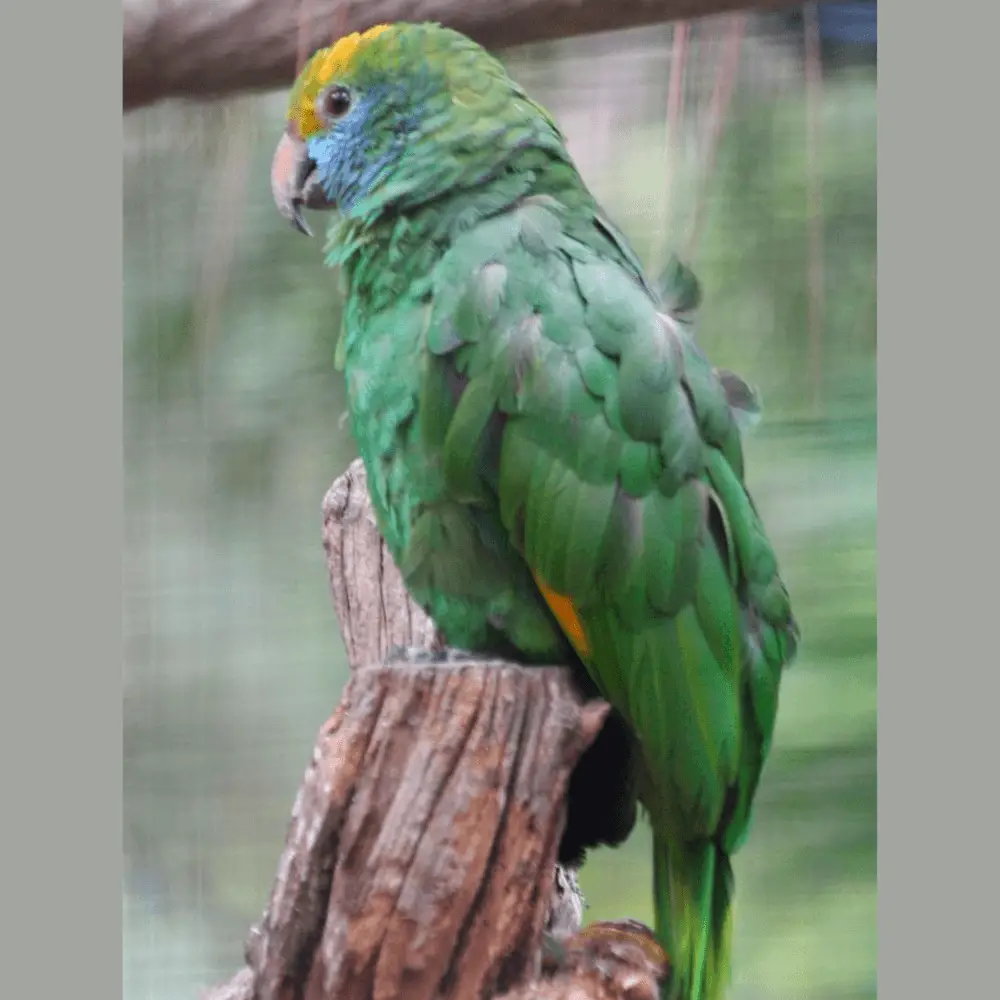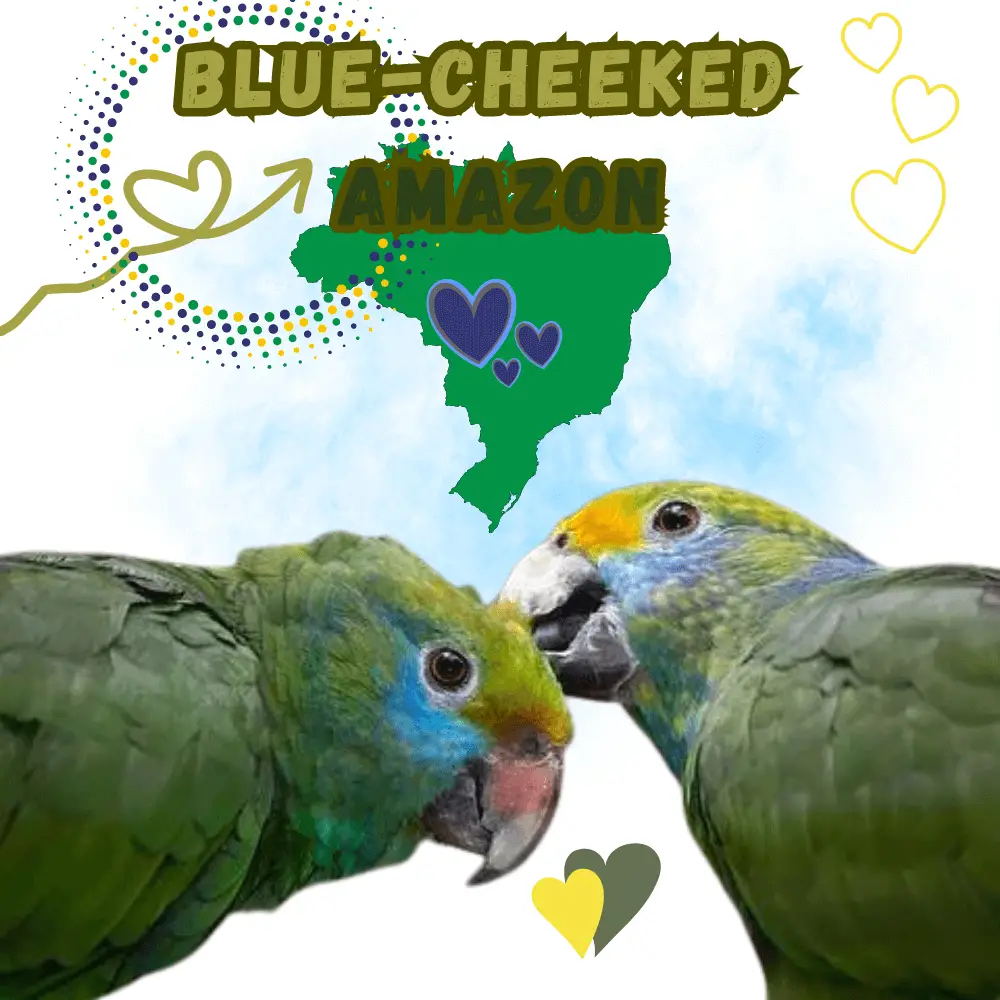Blue-cheeked Amazon: 37cm. length and 430 grams. The Blue-cheeked Parrot (Amazona brasiliensis) has a front, front crown, Red; subsequent red plumes crown with purple tips; cheeks, helmet ears, neck sides Yes throat, mauve-blue; back of the crown Yes nape, green with black tips.
The upper parts are Green, with some grupa feathers with yellow dots. The medium, large wings and the inner secondaries appear clearly yellow; the front border the red and yellow wing; the primary gray-black, and secondary green, fading to blue towards the tips.
Under the wings, yellow-green; black, and blue-colored flight feathers are on the basis of internal networks. Yellow-green underparts, paler under tail-coverts. Tail green with broad yellow-green tips, secondary feathers mostly marked with violet-blue on outer networks and with the tip of yellowish-green with a broad Red subterminal band.
Pale horn bill with black tip; Orange iris; gray-pink legs.
Both sexes are similar. The immature One is less extensive in the redhead, has darker plumage, and overall darker iris.
The molecular study suggests that this species is closest to the Orange-winged Amazon (Amazona amazonica). Previously it was thought to form a group with Dufresne’s Amazon (Amazona dufresniana) and the Red-browed Amazon (Amazona rhodocorytha), and it was treated as conspecific with one or two. monotypic.
- Order : Psittaciformes
- Family : Psittacidae
- Genus : Amazona
- Scientific name : Amazona brasiliensis
- Citation : ( Linnaeus , 1758)
- Protonimo : psittacus brasiliensis
- Origin: Brazil
- Character: Sociable.
- Height: 37cm.
Habitat

The Blue-cheeked amazon inhabits restricted areas or coastal lowland forests and wetlands with rare species and structural diversity, including lowland rainforests, restinga, freshwater marshes, and mangroves. Your favorite coastal habitats have intricate canal networks, marshes, and wetlands.
The characteristic trees of its forest habitat include Luehea Yes Andira, while the vegetation of the islands, where they sleep and reproduce, They are dominated by several Halophyte species and restinga formations.
Lives at altitudes not exceeding 300-400 m, Although there are records of 700 meters in Paraná. Forman roosts communally (often in mangroves) for at least part of the year, with over 750 birds reported at one meeting (1985).
Reproduction
They nest in the cavity of a living or dead tree, for example, Jerivá palms (Syagrus romanzoffianum) Yes guanandi (Callophyllum Brasiliense), and the nests of arboreal termites from time to time; height generally, but recorded only one nest 1 meter above the flood.
Usually it played in flooded or swampy areas, including mangroves. mating season in September for February, in some cases in April. Clutch 5-4 eggs. The eggs are incubated for 27 to 28 days, and the period until abandonment of the nest should last 50 to 55 days.
Food
The fruits of Callophyllum Brasiliense are considered to be of considerable importance in the diet of the Blue-cheeked amazon, with fruits Syagrus romanzoffianum Yes Psidium cattleyanum also taken in quantity; other recorded foods include flowers, fruits of Erythrina speciosa, fruits of Euphorbia y Myrcia and insects in fruits. They feed in pairs or groups of up to 20 birds.
Distribution and status

Blue-cheeked amazon is confined to a small coastal area in the southeast of Brazil, in the states of São Paulo and Paraná. In São Paulo’s coastal areas, It extends southwest of Itanhaém, including the long Isla and the Cardoso island, and practically all the coastal areas of neighboring Paraná, from Guaraqueçaba, Antonina Yes Paianagua, up to Guaratuba and several adjacent islands, for example at Žle Mel.
Possibly they inhabit far northeast Santa Catarina, adjacent to Paraná, but there is no reliable data. The old Rio Grande do Sul record seems unlikely. possibly some lower seasonal shifts in winter (May-August).
The rapid decline of the population in the twentieth century, is partly due to the loss of habitat, with most areas densely populated and totally deforested, the rest threatened are given by urbanization (for example, in Isla longue ), the felling of trees for nesting and food, as well as Palmas for human use (shipbuilding and food) and the conversion of wetlands for the production of water buffaloes and rice (birds also face competition from grazing animals for Erythrina speciosa fruit consumption).
However, direct human exploitation of the species is now no less of a serious problem, some linked to their hunting for food, although most suffer from their illegal capture for trade. A recent study 49 showed that nests 41 of them were illegally stolen their young, while the 1.27% available habitat was lost only in 1993.
total wild population estimated at 3,600 birds (1995) with a rapid decline of several hundred predicted. Range probably no more than 6,000 km2, with much of this extension susceptible to sea level rise caused by climate change.
protected by national law. They live in several protected areas (for example, in Žle Cardoso, sao paulo ), but in them, there is only a very small proportion of birds.
Conservation

• Demographic trend: Increasing.
• Population size: 6000-6700.
- The rationale for the Red List Category
The take for the bird cage trade and the loss of habitat are the main threats to this species. Despite the strong pressure to capture in the early nineties, It is believed that the range of the species has remained essentially the same, and the populations have been stable or have declined less sharply than expected, According to a recent estimate which suggests a growth in the people. Due to its small breeding range and highly fragmented habitat, the species is considered Vulnerable.
It is suspected that long-term conservation measures have contributed to recent population increases at an unquantified rate, although habitat fragmentation and poaching remain significant threats ( Waugh 2006 ).
The “Blue-cheeked Amazon” in Captivity
CITES Appendix I and II and protected by Brazilian legislation.
Each captive specimen of this species, which is capable of reproducing, is placed in a well-managed captive breeding program and is not to be sold as a pet, in order to guarantee long-term survival.
SOURCE: Video Ark
Related article:

